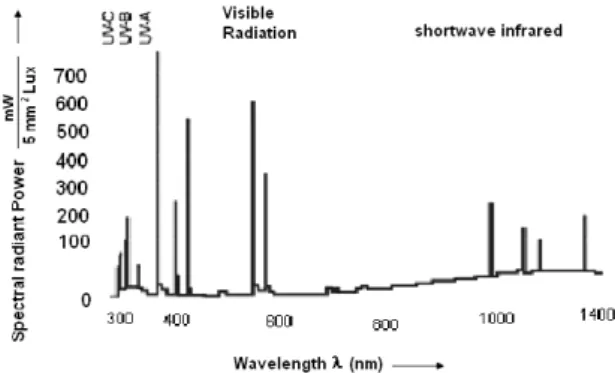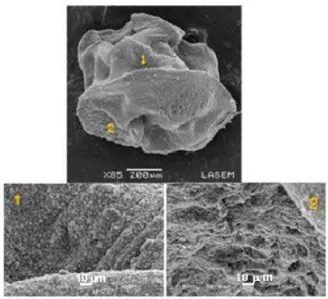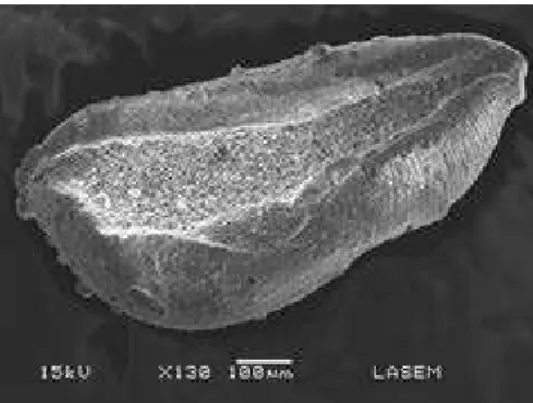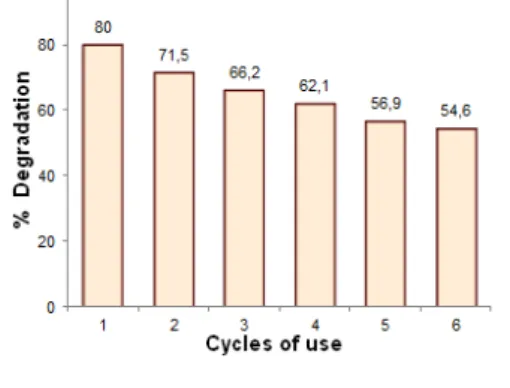ISSN 1517-7076 artigo 11636, pp.668-675, 2015
TiO
2soportada en partículas magnéticas
para la degradación de tartrazina
Tartrazine degradation by supported TiO
2on magnetic particles
Carla Lorena Heredia1,3, Edgrado Ling Sham1,2,
Elsa Mónica Farfán-Torres 1,3
1 INIQUI, CONICET, Universidad Nacional de Salta, Av. Bolivia N° 5150, CP: A4408FVY, Salta, Argentina.
e-mail: carlalheredia@gmail.com
2 Fac. de Ingeniería, Universidad Nacional de Salta, Av. Bolivia N° 5150, CP: A4408FVY, Salta, Argentina.
e-mail: edgardosham@gmail.com
3 Fac. de Ciencias Exactas, Universidad Nacional de Salta, , Av. Bolivia N° 5150, CP: A4408FVY, Salta, Argentina.
e-mail: mfarfantorres@gmail.com
RESUMEN
En el presente trabajo se han obtenido perlas magnéticas mediante la adición de una solución de alginato de sodio conteniendo partículas de magnetita a una solución de CaCl2, las cuáles fueron utilizadas como soporte
de TiO2. Las partículas de TiO2 en fase anatasa, obtenidas por el método sol-gel a baja temperatura (75 °C),
fueron soportadas en las perlas magnéticas para obtener el fotocatalizador magnético, CM. La superficie es-pecífica BET del núcleo de magnetita y el fotocatalizador magnético fueron obtenidas por adsorción de N2, la
morfología de las partículas fueron observadas por microscopía electrónica de barrido (SEM) y la fase TiO2
fue analizada mediante espectroscopía Raman. La actividad fotocatalítica de CM fue evaluada en la degrada-ción del colorante tartrazina, muy utilizado en la industria alimenticia, a dos concentraciones diferentes. Fi-nalmente, la estabilidad del catalizador fue evaluada mediante ensayos de la re-usabilidad en varios ciclos posteriores. Los resultados mostraron que la fase anatasa soportada en las partículas magnéticas presentan buena actividad fotocatalítica en la de degradación de tartrazina, principalmente cuando la concentración del colorante es baja, y que pueden ser fácilmente recuperados y re-utilizados en varios ciclos con una moderada pérdida en la eficiencia fotocatalítica.
Palabras clave: TiO2 soportado, perlas magnéticas, degradación de tartrazina.
ABSTRACT
Magnetic beads were obtained by dropping a solution of sodium alginate containing magnetite particles into a CaCl2 solution. TiO2 anatase particles were synthetized by a sol-gel method at low temperature (75 °C), and
were supported on magnetic beads to obtain the magnetic photocatalyst, MC. Magnetite particles and magne-tic photocatalyst were characterized by nitrogen adsorption (BET, surface area), their morphology observed by scanning electronic microscopy (SEM) and TiO2 phase was analyzed by means of Raman spectroscopy.
The photocatalytic activity of MC was evaluated on tartrazine degradation, highly used in food industry, at two different concentrations. Finally, MC stability was evaluated by reusability assays in several subsequent cycles. Results showed a good photocatalytic response for tartrazine degradation, especially at low concen-tration, easy recuperation and appropriate perform in the reusability of MC.
Keywords: supported TiO2, magnetic beads, tartrazine degradation.
1. INTRODUCTION
Heterogeneous photocatalysis using semiconductor TiO2 is widely used in environmental decontamination,
such as air purification or removal of organic and inorganic pollutants from waste waters. The TiO2
photo-catalyst shows attractive optical and electronic properties, high photocatalytic activity and chemical stability
Autor Responsable: Carla Lorena Heredia Fecha de envío: 29/12/2014 Fecha de aprobación: 22/04/2015
and non-toxicity. TiO2 presents three crystalline phases, anatase, rutile and brookite, being anatase the most
important in photocatalysis [1-4]. However, its particle sizes have limited practical application in suspension mainly because of its costs of separation. To overcome this problem, titania has been immobilized on several materials such as glass, ceramic and zeolites [5-8]. The photocatalytic activity of supported titania is consid-erably reduced because the effective surface area exposed in the supported systems is also decreased. Magnetic particles, such as magnetite (Fe3O4) and maghemite (γ-Fe2O3), have been studied for
poten-tials applications, especially in bioengineering and biomedicine areas [9-10]. They had demonstrated to be a good alternative to be used as supports of TiO2 particles, since they can be easily be separated from the
solu-tion by applicasolu-tion of a magnetic field. Nevertheless, previous studies have demonstrated that direct deposi-tion of titania on magnetic cores produce a critical decrease of photoactivity [11-12]. This behavior was re-lated with the formation of strong chemical interactions between iron oxide and titanium oxide phases that take place during the heat treatment used to develop anatasa phase, which modifies both photoactivity and magnetic properties [11-12].
On the other hand, magnetic particles have been stabilized by incorporation of interphase between magnetite and anatase phases, principally SiO2 matrix. This interphase has been demonstrated to be an
excel-lent option to insulate the iron oxide [13-17]. Moreover, other polymers have been studied to encapsulate Fe3O4 nanoparticles for different applications [18-19]. Particularly, sodium alginate which is an economical
and no-toxic polysaccharide has been applied to drug delivery [20-21] and adsorption of pollutant in waste water [22], but there are limited applications in photocatalysis [23-24].
In the present work, we synthetized a TiO2 photocatalyst supported on magnetic beads obtained by
encapsulation of magnetite particles in alginate matrix. The anatasa TiO2 phase was obtained by sol-gel
method at low temperature (75 °C). Its photoactivity was evaluated in degradation of azo-acidic tartrazine dye, which is often used to provide orange coloring to foods, drinks and pharmacological products. Tatrazine has been implicated as the food additive, most often responsible for allergic reactions, having thus been tar-geted by the scientific community. Some authors have studied the carcinogenetic and mutogenetic effects of tartrazine with variable results [25-26]. In spite of these health concerns, there are currently only a few stud-ies of tartrazine degradation by heterogeneous photocatalysis [27].
2. EXPERIMENTAL
2.1 Synthesis of magnetic photocatalyst
The magnetic beads were obtained by entrapping Fe3O4 nanoparticles in the matrix of sodium alginate.
Na-noparticles of commercial magnetite, provided by Alfa Aesar, were dispersed in 20 mL of sodium alginate solution at 2% m/v, in an ultrasonic bath for 30 min. The resultant suspension or “magnetic ferrofluid” was added dropwise in a solution of calcium chloride at 2% m/v, using a syringe. Magnetic beads were main-tained in the calcium bath overnight, so that the gelation reaction had enough time to be carried out in the whole volume of the bead. After the curing period, the beads were removed from the CaCl2 solution, washed
several times with distilled water and kept in a distilled water bath to remove the maximum amount of un-bounded calcium.
On the other hand, anatase TiO2 nanoparticles were prepared by the sol-gel method at low temperature
using a previously reported method [30]. Briefly,20 mL of water at pH = 2 (adjusted with HNO3) were
add-ed to 10 mL of 1M solution of titanium tetraisopropoxide (TTIP, by Aldrich 97%) in isopropyl alcohol (Cic-carelli P.A) under continuous stirring. A white sol was instantly obtained and was aged keeping it under re-flux condition at 75 ºC for 5 h. This time was previously determined as the optimal time to promote the ana-tase crystalline phase formation [30].
Finally, magnetic wet cores were added to titania sol in ultrasonic bath for 1 hour and then, they were totally dried in a rotary evaporator under vacuum (near 5.0 x 10-4 mbar) to obtain the magnetic catalyst, MC.
2.2 Characterization
The specific surface area (BET) of magnetite and photocatalyst was measured through nitrogen adsorption in a FlowSorb II Micromeritics single point equipment. After ageing time, a portion of TiO2 was centrifuged in
order to analyze its crystalline structure by Raman in GX Perkin Elmer spectrometer. The surface morpholo-gy of wet beads and magnetic catalyst was observed by scanning electron microscopy using JEOL model JSM 6480 LV microscopy.
2.3 Photocatalytic test
Photocatalytic activity of the sample was evaluated in a batch photoreactor which consisted of a glass beaker (500 mL) under mechanical stirring with vertical irradiation. The lamp used was a polychromatic Osram Ul-tra Vitalux 300W lamp with maximum emissions in UV-Visible spectrum zone, as it shows in Figure 1.
Figure 1: Emission spectrum of the lamp used in the photocatalytic tests.
The evolution of tartrazine degradation was followed by UV-V absorbance on GBC 918 spectropho-tometer, equipped with 50W halogen-tungsten and 30W deuterium lamps, at the wavelength of the maximum absorbance of dye, λ = 427.25 cm-1.
Firstly, a test was performed without irradiation (light blank) in order to evaluate the adsorption of dye on MC surface. Another test was achieved to analyse the effect of radiation UV on tartrazine decomposition without photocatalyst (TiO2 blank). Both tests were performed at tartrazine concentration of 2x10-5 M.
The photocatalytic activity was evaluated at two tartrazine concentrations, 1x10-5 M y 2x10-5 M. The tests were performed at room temperature with a catalyst loading of 2 g/L and pH=6 for all cases.
After first test, MC was recovered by a high potential magneto (3500 kgauss), washed and dried at oven at 100 °C. Finally, the photocatalyst reusability was evaluated in five subsequent cycle tests at tartrazine concentration of 1x10-5 M.
3. RESULTS AND DISCUSSION
3.1 Characterization
BET surface area of magnetite and magnetic photocatalyst were listed in Table 1. The Fe3O4 presents a low
surface area which shows an important increase after deposition of the titania phase.
Table 1: Specific surface area of magnetite and photocatalyst.
SAMPLE BET (m2
/g) Commercial Fe3O4 8
MC 29
Figure 2: Raman spectrum TiO2 phase obtained before deposition on the magnetic beads.
The Raman spectrum of TiO2 phase is presented in Figure 2. There are three strong absorption bands at 639, 516 and 398 cm-1 which are attributed to Eg, A1g-B1g, and B1g anatase modes, respectively [30]. This confirmed that TiO2 deposited on magnetic cores presented the desirable crystalline phase.
Figure 3 (a) presents a micrograph of a magnetic bead obtained by supercritical drying to avoid the collapse of the internal structure and its interior conformation. Beads present a rough surface as can be seen in the magnifications of the zones 1 and 2 also presented in figure 3 (a). Figure 3 (b) allows to see that the magnetite particles are completely coated by an alginate layer. Figure 3 (c) allows to see that magnetic beads obtained present a homogeneous particle size distribution.
Figure 3(a): SEM micrographs of a magnetic bead, with magnifications in regions 1 and 2.
Figure 3 (b): SEM micrograph of a cross-section of a magnetic bead.
Figure 3 (c): SEM micrograph of magnetic beads showing a homogeneous particle size distribution. 3.2 Photocatalytic activity
In figure 4 is presented the profile of photocatalytic tests at two mentioned tartrazine concentration and ad-sorption (A) and blank of TiO2 (B) tests. The percentage of tartrazine degradation was calculated as:
(1)
where C0 and Ct are the initial and final concentration of tatrazine, respectively.
Figure 4: Evolution of Tartrazine degradation with the time of reaction. 100
deg %
0 0− ×
=
C C
C t
In first place, the reduction of tartrazine concentration after adsorption test (light blank) on MC sur-face, presents a low value after 120 min in contact (3%). The blank of TiO2 test showed a decomposition of
2% after 120 min of irradiation, due to photolysis process of tartrazine when its molecules are exposed to UV radiation. Both values are very low and its effects can be neglected. In subsequent assays, the solutions with MC were stirring for 20 min before irradiation in order to allow adsorption equilibrium of the dye on catalyst surface.
It can be seen, the photocatalyst MC shows very good photocatalytic activity reaching a rate of tartra-zine degradation of around 80%, in 120 min of reaction, for lower dye concentration (1x10-5 M). When dye
concentration is doubled (2x10-5 M), the efficiency of photocatalyst exhibits an important diminution
reach-ing a 48% of decomposition in the same reaction time (120 min). Gupta and co-workers have found similar results for tartrazine degradation using commercial TiO2 (Aldrich), and they demonstrated the most efficient
degradation for an initial concentration of 2x10-5 M, the lowest concentration used in their work.
3.3 Reusability tests
In Figure 5 is presented reusability tests of magnetic catalyst in five cycles of use. These tests were per-formed using the optimal tartrazine concentration found it previously, 1x10-5 M.
Figure 5: Re-usability cycles tests, the % degradation corresponding to 120 min of reaction.
It can be seen, in the first reuse, MC produces a decrement around 9% in the efficiency of tartrazine degradation, respect for first use. In successive uses, this reduction is lower with an average around 5%, alt-hough MC reaches a degradation of dye superior at 50% after six uses. Decreasing between the first and sec-ond use can be associated to a possible loss of the anatase layer, probably weakly supported on magnetic beads. Another possibility can be attributed to rests of tartrazine molecules broken down and retained on MC surface.
Results reported in the literature shows that some products of tartrazine photodegradation in the pres-ence of H2O2 are acids like 4-phenolsulfonic, fumaric, formic, maleic, oxalic and malonic beside others [32].
Most of these products are known to be biodegradable under various conditions. Although in our case further studies are necessary to elucidate the mechanism and the products of degradation, we can expect than some of these are formed during tartrazine photodegradation with TiO2. All these acids could be adsorbed on ana-tase and longer contact times are necessary to reach complete mineralization [33].
4. CONCLUSIONS
The magnetic photocatalyst obtained by deposition of anatase TiO2 on magnetic beads showed a good
photo-activity for decomposition of tartrazina dye. Photocatalytic assays were performed for two concentrations of dye showing the best response to degrade tartrazina at 1x10-5 M. Magnetic properties facilitated its recovery
and reusability for five posterior cycles of use, showing a good behaviour yet.
ACKNOWLEDGEMENTS
We wish to thanks to the CIUNSa for the financial support by means of the Project Nº2150 and to CONICET for the PhD fellow of C.Heredia.
5. BIBLIOGRAPHY
[1] HOFFMAN, M. R., MARTIN, S. T., CHOI, W., et al, Environmental Applications of Semiconductor
Photocatalysis”, Chemical Review, v. 95, n. 1, pp. 69-96, Jan. 1995.
[2] LÓPEZ LOUVEIRA, E., FIOL, P. S., CURUTCHET, G., et al, “TiO2-photocatalytic treatment coupled
with biological systems for the elimination of benzalkonium chloride in water”, Separation and
Purification Technology, v. 91, pp. 108-116, May. 2012.
[3] PASSALÍA, C., MARTÍNEZ RETAMAR, M. E., ALFANO, O. M., et al, “Photocatalytic Degradation of Formal- dehyde in Gas Phase on TiO2 Films: A Kinetic Study”, International Journal of Chemical Reactor
Engineering, v. 8, n. 1, pp. 1-27, 2010.
[4] SATUF, M. L., PIERRESTEGUI, M. J. ROSSINI, L., et al, “Kinetic modeling of azo dyes photocatalytic degradation in aqueous TiO2 suspensions. Toxicity and biodegradability evaluation”, Catalysis Today, v.
161, n. 1, pp. 121-126, Mar. 2011.
[5] MA, Y., QIU, J., CAO, Y., et al, “Photocatalytic activity of TiO2 films grown on different substrates”,
Chemosphere, v. 44, n. 5, pp. 1087-1092, Aug. 2001.
[6] BHATTACHARYYA, A., KAWI, S., RAY, M. B., “Photocatalytic degradation of orange II by TiO2
catalysts supported on adsorbents”, Catalysis Today, v. 98, n. 3, pp. 431-439, Dec. 2004.
[7] BELESSI, V., LAMBROPOULOU, D., KONSTANTINOU, I., et al., “Structure and photocatalytic per-formance of TiO2/clay nanocomposites for the degradation of dimethachlor”, Applied Catalysis B:
Environmental, v. 73, n. 3-4, pp.292-299, May.2007.
[8] SHAN, A. Y., GHAZI, T. I. M., RASHID, S. A. “Immobilisation of titanium dioxide onto supporting materials in heterogeneous photocatalysis: A review”, Applied Catalysis A: General, v. 389, n. 1-2, pp. 1-8,
Dec. 2010.
[9] ZHANG, J., SUN, W., BERGMAN, L., et al., “Magnetic mesoporous silica nanospheres as DNA/drug carrier”, Material Letters, v. 67, n. 1, pp. 379-382, Jan. 2012.
[10] SEN, T., BRUCE, I. J. “Mesoporous silica–magnetite nanocomposites: Fabrication, characterization and applications in biosciences”, Microporous and Mesoporous Materials, v. 120, n. 3, pp. 246-251, Apr. 2009. [11] WATSON, S., BEYDOUN, D., AMAL, R. J., “Synthesis of a novel magnetic photocatalyst by direct deposition of nanosized TiO2 crystals onto a magnetic core”, Photochemistry and Photobiology A:
Chemis-try, v. 148, n. 1-3, pp. 303-313, May. 2002.
[12] BEYDON, D., AMAL, R. “Implications of heat treatment on the properties of a magnetic iron oxide-titanium dioxide photocatalyst”, Material Science and Engineering, v. B94, n. 1, pp. 71-91, Jun. 2002.
[13] WATSON, S., SCOTT, J., BEYDOUN, D., et al, “Studies on the preparation of magnetic
photocata-lysts” Journal of Nanoparticles Research, v. 7, n. 6, pp. 691-705, Dec. 2005.
[14] XU, J., AO, Y., FU, D., et al, “Low-temperature preparation of anatase titania-coated magnetite”,
Jour-nal of Physics Chemistry of Solids, v. 69, n. 8, pp. 1980-1984, Aug. 2008.
[15] CHEN, F., XIE, Y., ZHAO, J., “Photocatalytic degradation of dyes on a magnetically separated photo-catalyst under visible and UV irradiation”, Chemosphere, v. 44, n. 4, pp. 1159-1168, Aug. 2001.
[16] GAD-ALLAH, T. A., KATO, S., SATOKAWA, S., et al, “Role of core diameter and silica content in
photocatalytic activity of TiO2/SiO2/Fe3O4 composite”, Solid State Science, v. 9, n. 8, pp. 737-743, Aug.
2007.
[17] ÁLVAREZ, P. M., JARAMILLO, J., LÓPEZ-PIÑERO, F., et al, “Preparation and characterization of
magnetic TiO2 nanoparticles and their utilization for the degradation of emerging pollutants in water”,
Ap-plied Catalysis B: Environmental, v. 100, n. 1-2, pp. 338-345, Oct. 2010.
[18] NEAUMTU, J., VERGA, N., “Magnetic Nanoparticles for Magneto-Resonance Imaging and Targeted Drug Delivery”, Digest Journal of Nanomaterials and Biostructures, v. 6, n. 3, pp. 969-978, Jul-Sep. 2011
.
[19] ZHENG, W.,GAO, F., GU, H., “Magnetic plymer nanospheres with high and uniform magnetite con-tent”, Journal of Magnetism and Magnetic Materials, v. 288, pp. 403-410, Mar. 2005.
[20] MA, H. L., MAITANI, Y., NAGAI, T. “Preparation and characterization of superparamagneticiron ox-ide nanoparticles stabilized by alginate”, International Journal of Pharmaceutics, v. 333, n. 1-2, pp.
177-186, Mar. 2007.
[21] FINOTELLI, P. V., SILVA, D., SOLA-PENNA, M., et al., “Microcapsules of alginate/chitosan contain-ing magnetic nanoparticles for controlled release of insulin”, Colloids and Surfaces B: Biointerfaces, v. 81, n.
1, pp. 206-211, Nov. 2010.
[22] ROCHER, V., SIAUGUE, J. M., CABUIL, B., et al, “Removal of organic dyes by magnetic alginate
beads”, Water Research, v. 42, n. 4-5, pp. 1290-1298, Feb. 2008.
[23] IDRIS, A., HASSAN, N., ISMAIL, N. S. M., et al., "Photocatalytic magnetic separable beads for chro-mium (IV) reduction", Water Research, v. 44, n.6, pp.1683-1688, 2010.
[24] IDRIS, A., HASSAN, N., RASHID, R., et al, “Kinetic and regeneration studies of photocatalytic mag-netic separable beads for chromium (VI) reduction under sunlight”, Journal of Hazardous Materials, v. 186, n. 1, pp. 629-635, Mar. 2010.
[25] MOUTINHO, I. L. D., BERTGES, L.C., ASSIS, R. V. C. “Prolonged use of the food dye tartrazine (FD&C yellow nº5) and its effects on the gastric mucosa of Wistar rats”, Brazilian Journal of Biology, v. 67,
n.1, pp. 141-145, Feb. 2007.
[26] SASAKI, Y. U., KAWAGUCHI, F. S., KAMAYA, A., et al., “The comet assay with 8 mouse organs: results with 39 currently used food additives”, Mutation Research, v. 519, n. 1-2, pp. 103-119, Aug. 2002.
[27] HASHIM, H. A. A., MOHAMED, A. R., TEONG, L. K., “Solar photocatalytic degradation of tartra-zine using titanium dioxide”, Jurnal Teknologi, v. 35F, pp. 31-39, Dec. 2001.
[28] RAO, K. V. S., LAVÉDRINE, B., BOULE, P., “Influence of metallic species on TiO2 for the photocata-lytic degradation of dyes and dye intermediates”, Journal of Photochemistry and Photobiology A: Chemistry,
v. 154, n. 2-3, pp. 189-193, Jan. 2003.
[29] GUPTA, V. K., JAIN, R., NAYAK, A., et al, “Removal of the hazardous dye-Tartrazine by
photodegra-dation on titanium dioxide surface”, Materials Science and Engineering C., v. 31, n. 5, pp. 1062-1067, Jul.
2011.
[30] HEREDIA, C. L., CORNEJO, R., SHAM, E. L., et al., “Síntesis de titania soportada sobre partículas magnéticas: Evaluación de su actividad fotocatalítica.”, VII Jornadas de Ciencia y Tecnología de Facultades
de Ingeniería del NOA, Catamarca, Argentina, Oct. 2011.
[31] PARKODI, K., AROKIAMARY, S. D. “Synthesis and spectroscopic characterization of nanostructured anatase titania: A photocatalyst”, Materials Characterization, v. 58, n. 6, pp. 495-503, Jun. 2007.
[32] BEACH, E. S., MALECKY, R. T., GIL, R. R., et al, “Fe-TAML/hydrogen peroxide degradation of con-centrated solutions of the commercial azo dye tartrazine”, Catalysis Science and Technology, v.1, pp. 437–
443, March 2011.
[33] DIEBOLD, U. “The surface science of titanium dioxide”, Surface Science Reports, v. 48, pp. 53 – 229,
January 2003.



